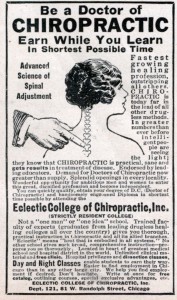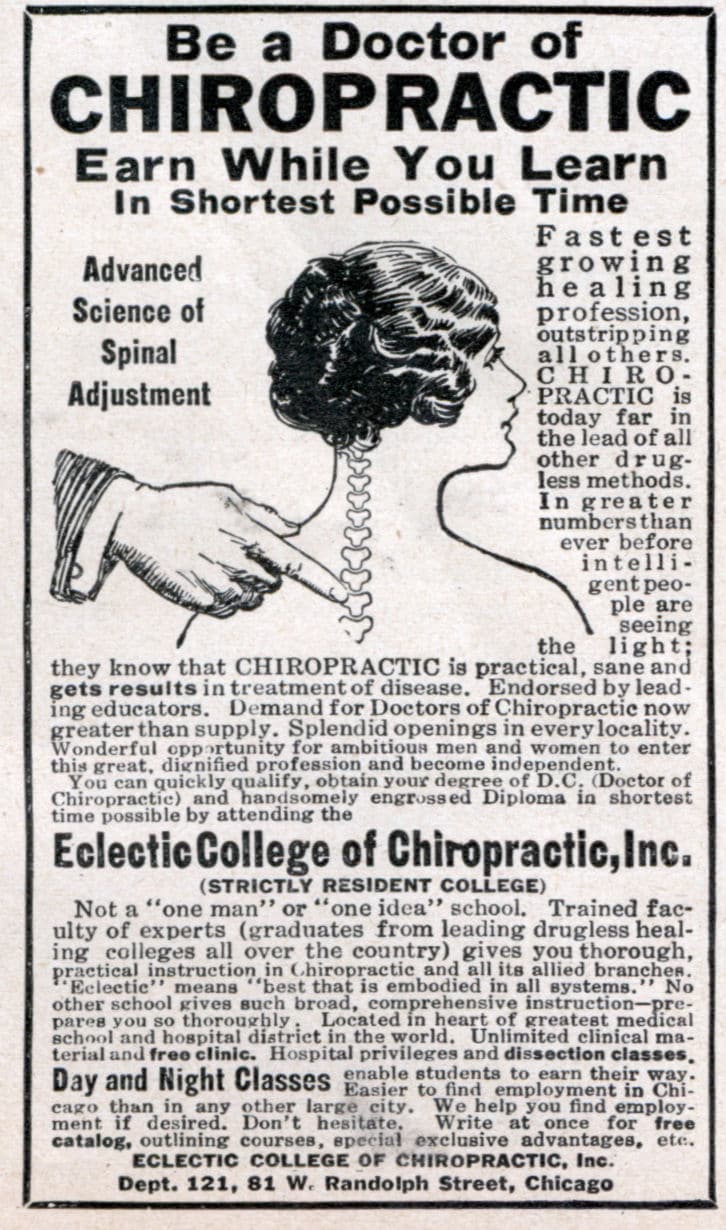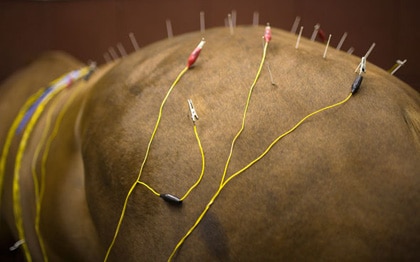Daryl D. Wills, D.C., president of the American Chiropractic Association (ACA) has complained about a program broadcast June 4, 2002, by Scientific American Frontiers and posted to the SAF Web site. The program, which was outstanding, acknowledged that spinal manipulation might be useful for acute low back pain. But it also noted that chiropractic’s basic theory is nonsense and that neck manipulation can be dangerous.
 In his open letter to PBS, “Setting the Record Straight,” ACA president Daryl Wills chastises the broadcasting company for ignoring “the scientific foundation of the chiropractic profession.” He then launches into an inaccurate and selective rebuttal.
In his open letter to PBS, “Setting the Record Straight,” ACA president Daryl Wills chastises the broadcasting company for ignoring “the scientific foundation of the chiropractic profession.” He then launches into an inaccurate and selective rebuttal.
Dr. Wills begins with an ad hominem attack on the National Council Against Health Fraud. That is, rather than address the criticisms provided by the council, he attacks the council itself as biased and unreliable. Such a tactic is a common and illegitimate form of argument, and the same charge could certainly be leveled at the American Chiropractic Association. Still, appropriate argument would be directed at the foundation by which conclusions are drawn. Here, Dr. Wills’ letter falls apart.
Dr. Wills attempts to rebut the assertion made by Dr. Robert Baratz of NCAHF that there is no scientific basis for chiropractic care. Dr. Wills cites studies to support his assertions, but a close look at these studies indicates that they fail to do so.
Dr. Wills reports that in 1994, the Agency for Health Care Policy and Research (AHCPR), Department of Health and Human Services, recommended spinal manipulation as an initial form of therapy for low back sufferers, finding it both “safe and effective.” This is true. However, Dr. Wills neglects to mention that the report did not endorse chiropractic. He also fails to note that the 1994 recommendations are “outdated due to more recent research findings or technological advances and are no longer viewed as guidance for current medical practice.” [1]
Dr. Wills reports on a single study which concluded that spinal manipulation resulted in almost immediate improvement for cervicogenic headaches. Although there is some support for such an assertion, a systematic review of chiropractic interventions for cervicogenic headaches concluded, “Before any firm conclusions can be drawn, further testing should be done in rigorously designed, executed, and analyzed trials with follow-up periods of sufficient length.” [2]
Dr. Wills notes that there are “other” positive studies that support chiropractic. Interestingly, he fails to report that there are numerous negative studies. That’s why it’s important to look at the totality of the evidence. When that is done, “The most rigorous of these studies suggest that spinal manipulation is not associated with clinically-relevant specific therapeutic effects.” [3]
Dr. Wills highlights a study published in the 1995 British Medical Journal that found that for long-term low back pain, “Improvement in all patients at three years was about 29% more in those treated by chiropractors than in those treated by the hospitals.” Interestingly, he fails to note that the 29% advantage of chiropractic over hospital management at three years (29%) sounds impressive but refers to an improvement of three points on the 100 point scale used in the study, or one and a half responses on the questionnaire. This difference may have been statistically significant but it is clinically trivial. Furthermore, chiropractic care was significantly more expensive — the measured improvement does not seem to support such expenditure [4].
Dr. Wills criticizes the PBS program for failing “to cite any of the countless examples of chiropractic’s successful integration into today’s health care system.” What this has to do with scientific evidence of efficacy is not apparent. Hospitals have long had clergy available to consult with patients - this does not also mean that hospitals endorse religions. Regardless, if and when - but not until — chiropractic care has scientific support, one can be assured that it will be assimilated into the mainstream of medical care (assuming that such assimilation is desired by the chiropractic profession).
Dr. Wills asserts that the risks of cervical manipulation and injury to cervical vertebral arteries are minimal and have been distorted by critics. That is simply not true. In fact, the true incidence of these events is unknown. In fact, 42 individual cases of serious adverse events have been reported in a review of the medical literature from 1995 to 2001 and most were seen by chiropractors [5]. Large and rigorous prospective studies of cervical spine manipulation - not “estimates” — are needed to accurately define the risks, as are sober discussions about whether the risks outweigh any potential benefit.
Dr. Wills then attempts to defend the risks of cervical manipulation by asserting that there are risks of medications. This is a logical fallacy known as tu quoque (you did it, too), whereby one attempts to deflect criticism by accusing the opposing party of the same “sin.” There are certainly risks of medication, however, unlike chiropractic, there are also demonstrable benefits. For example, non-steroidal anti-inflammatory drugs have been exhaustively reviewed and evidence from numerous trials suggests that they are effective for managing acute low back pain [6] — in contradistinction to chiropractic care.
Furthermore, the risks of adverse drug reactions appear to have been wildly over-estimated. Again, Dr. Wills cites a study without examining the totality of the evidence. The figures cited in the 1998 JAMA study were immediately contested [7]. While there are certainly fatal reactions to drugs, many of these are unavoidable, or occur in patients who are succumbing to disease processes anyway. Moreover, the medical community monitors the risks of their interventions and attempts to quantify and reduce them; the chiropractic community denies them.
Dr. Wills asserts, “Far too many patients — young and old — have their pain treated with medication that may have side effects that do not correct the underlying source of their problem.” This is illogical argument. In many cases of back pain, the underlying source of the problem is often unknown. However, it is clearly not described by any of the numerous explanations offered by chiropractors; in particular, it is not described by the elusive and unproven “subluxation.”
Finally, while putative beneficial effects of the myriad of unrelated chiropractic interventions is unsupported by science, it is also of concern that chiropractic professional organizations also demonstrate an antipathy towards science. Indeed, “The largest professional associations in the United States and Canada distribute patient brochures that make claims for the clinical art of chiropractic that are not currently justified by available scientific evidence or that are intrinsically untestable.” [8]
Facts that contradict chiropractic claims may make the chiropractic profession uncomfortable. However, denying these will not advance the chiropractic cause.
References
- http://www.ahcpr.gov/clinic/cpgonline.htm
- Bronfort G, Assendelft WJ, Evans R, Haas M, Bouter L. Efficacy of spinal manipulation for chronic headache: a systematic review. J Manipulative Physiol Ther. 2001; 24(7):457-66.
- Ernst E, Harkness E. Spinal manipulation: a systematic review of sham-controlled, double-blind, randomized clinical trials. J Pain Symptom Manage. 2001; 22(4):879-89.
- Greenough, CG. Results were clinically trivial. BMJ 1995; 311: 1302.
- Ernst E. Manipulation of the cervical spine: a systematic review of case reports of serious adverse events, 1995-2001. Med J Aust 2002; 176(8): 376-80.
- van Tulder MW, Scholten RJ, Koes BW, Deyo RA. Nonsteroidal anti-inflammatory drugs for low back pain: a systematic review within the framework of the Cochrane Collaboration Back Review Group. Spine. 2000; 25(19): 2501-13.
- JAMA 1998; 280(20)
- Grod JP, Sikorski D, Keating JC Jr. Unsubstantiated claims in patient brochures from the largest state, provincial, and national chiropractic associations and research agencies. J Manipulative Physiol Ther. 2001; 24(8):514-9.







